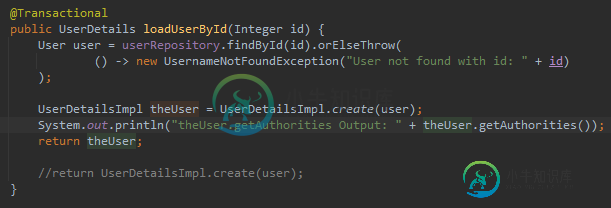Spring Security-401未经授权的访问

只要我的antMatcher上有.permitall(),这就可以很好地工作,但是当我试图保护它以便只有管理员才能进行该调用时(DB中的管理员角色是ROLE_ADMIN),它会返回401未经授权的访问,并且没有消息。我试过了
- .hasRole(“admin”)
- .hasRole(“role_admin”)
- .hasAuthority(“admin”)
- .hasAuthority(“role_admin”)


我的请求如下所示(为标题张贴):

@Configuration
@EnableWebSecurity
@EnableGlobalMethodSecurity(
securedEnabled = true,
jsr250Enabled = true,
prePostEnabled = true
)
public class SecurityConfig extends WebSecurityConfigurerAdapter {
@Autowired
UserDetailsServiceImpl userDetailsService;
@Autowired
private JwtAuthenticationEntryPoint unauthorizedHandler;
@Bean
public JwtAuthenticationFilter jwtAuthenticationFilter() {
return new JwtAuthenticationFilter();
}
@Override
public void configure(AuthenticationManagerBuilder auth) throws Exception {
auth.userDetailsService(userDetailsService).passwordEncoder(passwordEncoder());
}
@Bean(BeanIds.AUTHENTICATION_MANAGER)
@Override
public AuthenticationManager authenticationManagerBean() throws Exception {
return super.authenticationManagerBean();
}
@Bean
public PasswordEncoder passwordEncoder() {
return new BCryptPasswordEncoder();
}
@Override
protected void configure(HttpSecurity http) throws Exception {
http
.cors()
.and()
.csrf()
.disable()
.exceptionHandling()
.authenticationEntryPoint(unauthorizedHandler)
.and()
.sessionManagement()
.sessionCreationPolicy(SessionCreationPolicy.STATELESS)
.and()
.authorizeRequests()
.antMatchers("/",
"/favicon.ico",
"/**/*.png",
"/**/*.gif",
"/**/*.svg",
"/**/*.jpg",
"/**/*.html",
"/**/*.css",
"/**/*.js")
.permitAll()
.antMatchers("/api/auth/**")
.permitAll()
.antMatchers("/api/book/**")
.permitAll()
.antMatchers("/api/author/**")
// .permitAll()
.hasAnyRole("ROLE_ADMIN", "ADMIN", "ROLE_USER", "USER", "ROLE_ROLE_ADMIN",
"ROLE_ROLE_USER")
.anyRequest()
.authenticated();
http.addFilterBefore(jwtAuthenticationFilter(), UsernamePasswordAuthenticationFilter.class);
}
}
@Service
public class UserDetailsServiceImpl implements UserDetailsService {
@Autowired
UserRepository userRepository;
@Override
@Transactional
public UserDetails loadUserByUsername(String email)
throws UsernameNotFoundException {
User user = userRepository.findByEmail(email);
return UserDetailsImpl.create(user);
}
@Transactional
public UserDetails loadUserById(Integer id) {
User user = userRepository.findById(id).orElseThrow(
() -> new UsernameNotFoundException("User not found with id: " + id)
);
return UserDetailsImpl.create(user);
}
}
@Component
public class JwtAuthenticationEntryPoint implements AuthenticationEntryPoint {
private static final Logger logger = LoggerFactory.getLogger(JwtAuthenticationEntryPoint.class);
@Override
public void commence(HttpServletRequest httpServletRequest, HttpServletResponse httpServletResponse,
AuthenticationException e) throws IOException, ServletException {
logger.error("Unauthorized access. Message:", e.getMessage());
httpServletResponse.sendError(HttpServletResponse.SC_UNAUTHORIZED, e.getMessage());
}
}
public class JwtAuthenticationFilter extends OncePerRequestFilter {
@Autowired
private JwtTokenProvider tokenProvider;
@Autowired
private UserDetailsServiceImpl userDetailsService;
private static final Logger logger = LoggerFactory.getLogger(JwtAuthenticationFilter.class);
@Override
protected void doFilterInternal(HttpServletRequest httpServletRequest, HttpServletResponse
httpServletResponse, FilterChain filterChain) throws ServletException, IOException {
try {
String jwt = getJwtFromRequest(httpServletRequest);
if(StringUtils.hasText(jwt) && tokenProvider.validateToken(jwt)) {
Integer userId = tokenProvider.getUserIdFromJWT(jwt);
UserDetails userDetails = userDetailsService.loadUserById(userId);
UsernamePasswordAuthenticationToken authentication = new
UsernamePasswordAuthenticationToken(userDetails, null, userDetails.getAuthorities());
authentication.setDetails(new
WebAuthenticationDetailsSource().buildDetails(httpServletRequest));
}
} catch (Exception e) {
logger.error("Could not set user authentication in security context", e);
}
filterChain.doFilter(httpServletRequest, httpServletResponse);
}
private String getJwtFromRequest(HttpServletRequest request) {
String bearerToken = request.getHeader("Authorization");
if (StringUtils.hasText(bearerToken) && bearerToken.startsWith("Bearer ")) {
return bearerToken.substring(7, bearerToken.length());
}
return null;
}
}
public class UserDetailsImpl implements UserDetails {
private Integer id;
@JsonIgnore
private String email;
private String name;
@JsonIgnore
private String password;
private boolean isAdmin;
private Collection<? extends GrantedAuthority> authorities;
public UserDetailsImpl(Integer id, String email, String name, String
password, boolean isAdmin, Collection<? extends GrantedAuthority>
authorities) {
this.id = id;
this.name = name;
this.email = email;
this.password = password;
this.authorities = authorities;
this.isAdmin = isAdmin;
}
public static UserDetailsImpl create(User user) {
List<GrantedAuthority> authorities = user.getRoles().stream().map(role ->
new SimpleGrantedAuthority(role.getName().name())
).collect(Collectors.toList());
boolean isAdmin = false;
for(Role role: user.getRoles()) {
if(RoleName.ROLE_ADMIN.equals(role.getName())) {
isAdmin = true;
}
}
return new UserDetailsImpl(
user.getId(),
user.getEmail(),
user.getName(),
user.getPassword(),
isAdmin,
authorities
);
}
public Integer getId() {
return id;
}
public String getName() {
return name;
}
@Override
public String getUsername() {
return email;
}
@Override
public String getPassword() {
return password;
}
public boolean isAdmin() {
return isAdmin;
}
@Override
public Collection<? extends GrantedAuthority> getAuthorities() {
return authorities;
}
@Override
public boolean isAccountNonExpired() {
return true;
}
@Override
public boolean isAccountNonLocked() {
return true;
}
@Override
public boolean isCredentialsNonExpired() {
return true;
}
@Override
public boolean isEnabled() {
return true;
}
@Override
public boolean equals(Object o) {
if (this == o) return true;
if (o == null || getClass() != o.getClass()) return false;
UserDetailsImpl that = (UserDetailsImpl) o;
return Objects.equals(id, that.id);
}
@Override
public int hashCode() {
return Objects.hash(id);
}



共有1个答案
我看到您没有更新SecurityContextHolder。无法把它放在一个评论,所以我写在这里。
authentication.setDetails(new WebAuthenticationDetailsSource().buildDetails(httpServletRequest))
SecurityContextHolder.getContext().setAuthentication(authentication); //this seems missing
-
我的代码:GoogleCredential凭据 credential.refreshToken() 错误日志: 创建服务号的步骤: 我在凭据中的oauth 2.0中创建了一个Web应用程序 然后我用客户端ID创建了一个服务号 现在我正在使用这个服务号和从它生成的p12证书来验证和创建Google凭据的对象 一旦刷新令牌,我就给了我401例外。 在这种情况下,任何帮助都会受到感激
-
我想使用爪哇谷歌驱动器API。我尝试了这段代码: 但是我得到了这个错误: 我使用以下配置: 你能告诉我怎么解决这个问题吗?
-
null null 使用NodePort服务公开Keycloak。 应用程序使用istio入口网关公开。 Keycloak服务器版本:9.0.0。
-
我正在尝试登录基于cloudflare服务器的网站。我使用cloudserver绕过了登录问题,但我的下一个停止点是当我试图发送get请求以访问一些登录后令牌时。 我的代码: 这返回401作为答案: 它的标题是 好的,我首先试着给一个auth。这样地 我再次得到相同的错误,401,但这次响应的头确实有一个www身份验证,我应该质询 根据我所读到的内容,它是基本的意味着我必须在我的头文件中添加一个像
-
Microsoft.Graph REST.API 我试图通过https://graph.microsoft.com/v1.0/me从graph.api获得有关我的信息 我也在这里检查这个其他主题,但我找不到像我一样的错误
-
我正在使用Maven Jib插件将我的应用程序部署到Gitlab docker注册表。如果我使用并输入用户名和密码,我可以成功登录gitlab注册表。我可以看到

